
International Trade Consultants
"Overlooking Runway 25 - Right, at Los Angeles International Airport"
Page Number 16
Year 2011
The Individual Moments of Transport Crisis
Which Don't Constitute A Full Page Feature
"Singles Only" Year 2011 - Our Feature Page - Page #16 - Our "Singles" Photo Features By Date
"Aboard The Polar Express" - Adirondack Scenic Railroad - Dec. 11 2011"Whooping Open A Can of Deere" - M/V MSC Nederland - Oct. 31 2011
"Rena Rocks With An Astrolabe" - M/V Rena - Oct. 5 2011
"Miracle At Guyana" - July 30 2011
"Malibu's Navy" - June 11 & 12 2011
"Capsize In Cadiz" - May 2011
"..... And The Bridge Is Out" - May 2011
"The Cargo Was Science" - Canada - Apri; 2 2011
"Movable Feast" - Waterfront - March 11 2011
"The Beauty of Cargo Loss" - March 9 2011
Only A Few Picture Series Result In A The Cargo Letter Photo Feature Page.
For All The Rather Amazing Single Picture Contributions We Recieve --
-- Here Are Our Selected One Photo Wonders!
The Air & Ocean Logistics- Customs Broker Attorneys
International Trade Consultants
"Overlooking Runway 25 - Right, at Los Angeles International Airport"
Countryman & McDaniel
Transport Single Photo Nightmares
Contributed By Our Readers* REURN TO "Singles Only" MAIN INDEX
|
|
|
Adirondack Scenic Railroad's Alco RS-18 ready For Polar Express Runs Polar Express - Hear The Music Departing Union Station, Utica, New York Daily For A Magical Ride To The North Pole More Christmas TainsI enjoyed the picture of the Adirondack Scenic Railway Christmas train. You may not be aware that CP Rail runs a Christmas train every year complete with entertaiment (the entertainers live in a couple of beautiful private cars). The train (actually 2 of them) goes across Canada and the U.S. One boxcar has been modified to serve as a stage. People are asked to bring donations to local food banks when they come to see the train. CONTRIBUTOR For This Feature: Rich. BausPat Smith |
|
|
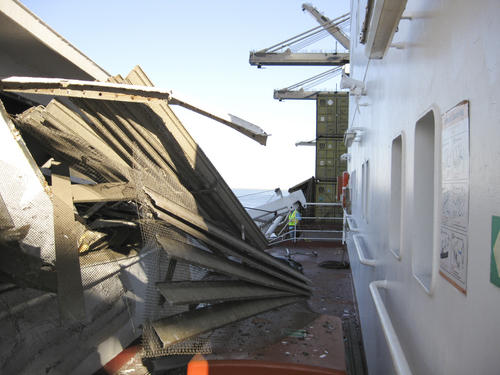
The Collision Causes 3 Containers To Fall From M/V MSC Nederland Onto The Deck of M/T Elka Apollon From The Cargo Letter - Oct. 5 2011Greek flagged, 799-foot tanker M/T Elka Apollon with 24 crew on board (10 Greeks & 14 internationals) collided with Panama flagged vessel M/V MSC Nederland in the Houston Ship Channel on Oct. 31 2011, causing damage to both and a small hydraulic fuel leak. 
782-Foot M/V MSC Nederland Looses 3 Containers In The Collision M/T Elka Apollon Has Whooped Open A Can of Deere On M/V MSC Nederland The Tractors Were Rearranged In The Collision, But John Deere Corp. Is Know To Carry High Quality Marine Cargo Insurance - Because "Ship Happens"! CONTRIBUTOR For This Feature: An important contributor who must remain anonymous |
|
|
 From The Cargo Letter - Oct. 5 2011 - stranded at Astrolabe Reef, off Tauranga, Maritime New Zealand47,230-dwt Liberian-flagged boxship M/V Rena (IMO: 8806802, built 1990, 3029 TEU) carrying 25 crew struck the Astrolabe Reef and grounded on Oct 5. Several breaches have been identified in the hull but no breaches in the fuel tanks. A light sheen of oil was detected in the surrounding water which is able to be dispersed easily. No injuries. [From our Sr. Correspondent Tim Schwabedissen, 5-10-11] 
Astrolabe Reef Peaks From The Sea -- Tip of The Berg From The Cargo Letter - Oct. 5 2011 - stranded at Astrolabe Reef, off Tauranga, Maritime New ZealandMaritime New Zealand says hydraulic oil has spilt from M/V Rena which has struck a reef near the Tauranga Harbour on Oct. 5, however the vessel's fuel tanks are still intact. 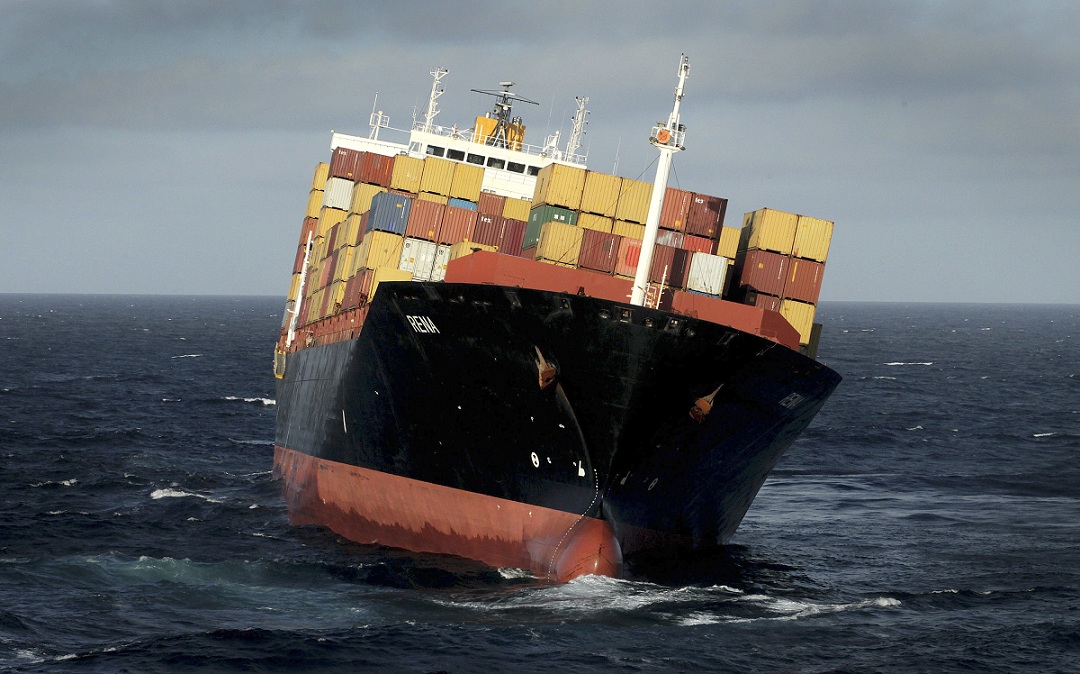
Expanded Photo Feature - we continue to follow the story of M/V Rena From The Cargo Letter - Oct. 7 2011 - stranded at Littlehampton, UKLightering operations will begin on October 10 with the focus of removing the heavy oil and diesel fuel from M/V Rena first. A naval architect is expected on scene and to evaluate if any other cargo will need to be lightered off M/V Rena before salvage can begin. The tug M/V Waka Kume out of Auckland has been charted to assist in the salvage operation. The tug is expected to be on scene by the next day. CONTRIBUTORS For This Feature Simon Dutto |
|
|
|
A Caribbean Airlines Boeing 737-800 In Better Days From The Cargo Letter - July 30 2011 - Miracle At GuyanaCaribbean Airlines flight BW-523 from Trinidad seemingly overshot the runway at the Cheddi Jagan International Airport in Guyana at 1.32 a.m. Saturday, July 30. The Boeing 737-800 broke in two pieces. There were no fatalities among the 163 passengers and crew on board although 35 people were treated for injuries at medical facilities in Guyana. 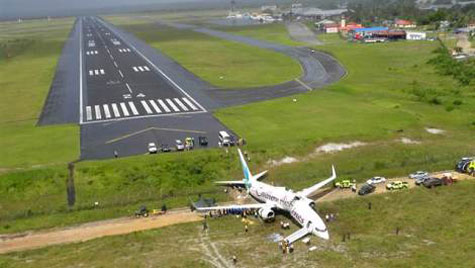
Flight BW-523 Overshot Runway 06 At 1.32 a.m. On July 30 2011 Preliminary Findings By Investigators Point To Pilot Error Rather Than Mechanical Or Other System Malfunctions
Investigators Believe The Pilot of The Four Year Boeing 737-800 Old Had Not Dropped His Flaps Prior To Landing From The Cargo Letter - Aug. 5 2011 - Miracle At GuyanaAccording to a report in the Wall Street Journal, preliminary findings by investigators into the July 30 Caribbean Airlines crash landing in Guyana point to pilot error rather than mechanical or other system malfunctions. The findings were based on eyewitness accounts and data retrieved from the plane's data-recorders 
Whatever The Cause -- 162 Passengers & Crew Walked Aaway From This Miracle At Guyana The Belly Cargo Did Not Fare As Well The Miracle Landings of 2009We will never forget the January 2009 "Miracle On The Hudson" when US Airways Flight 1549 survived it's 3 minute flight -- and was successfully landed in the Hudson River of New York with the courage and skill of Captain Chesley B. Sullenberger, III. The "Miracle" was simply stated: there were no fatalities. Captain Chesley B. Sullenberger, III performed the improbable!Our Photo Feature: "Miracle On The Hudson" -- Includes The Complete History of Aircraft Water Landings |
|
|
From The Cargo Letter - June 12 2011 - Malibu's NavyThe affluent, beachfront city of Malibu in western Los Angeles County, California, United States, with a population was 12,645 and home to movie stars, now sports its own navy, as the AEGIS guided missle destroyer USS John Paul Jones DDG 53 made a one-of-a-kind port call on the June 11 - 12 2011 weekend for Navy Days. The 505-foot-long guided missile destroyer is a member of the U.S. Third Fleet, based in San Diego. "Ships like this don't normally visit open ocean piers," said City Council member Jefferson "Zuma Jay" Wagner. "It's very, very rare. They usually dock in a harbor. This has never been done before in the city of Malibu." Tours of the vessel for all were conducted by shore boat over the week end. The vessel is named for America's greatest naval hero -- American Revolutionary War Captain John Paul Jones. Only In California The 505 Foot USS John Paul Jones DDG 53 Is Showcased Behind Two of Malibu Navy's More Numerous Coastal Patrol Craft Your Editor Turned Out With The Entire Town To Welcome USS John Paul Jones DDG 53 On Malibu Pier The John Paul Jones Crew of 338 Experienced Some Malibu-style R&R During The Special Weekend End And Were Guests of Honor At A Private Barbecue. In The Words of Malibu"If you happen upon any of these fine men and women, please do extend your hand in gratitude for their dedication and service. It means so much to them to know that when they are deployed overseas, their family is supported by all of us so let's give them that memory to hold onto during the time they are separated. Buy them a cup of coffee, send over a dessert but of all that each of us could do it's the extension of gratitude that they hold close wherever they are. And a few adopt-a-soldier dinners will be held" |
|
|
|
|
|
|
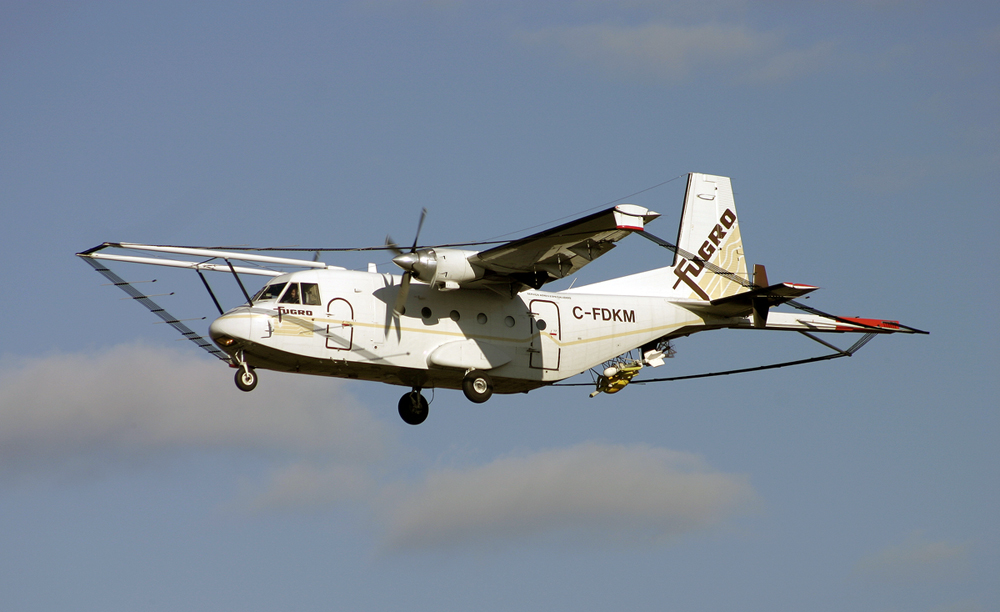
Fugro Corp.'s CASA 212 In Better Days This Amazing Aircraft Is Outfitted For Aerial Mineal Discovety & Earth Sciences Exploration Unfortunately, Fugro Corp.'s CASA 212 Suffered Engine Failure On Her April 2 2011 Takeoff From Saskatoon, Canada
Fugro Corp.'s CASA 212 Suffered Engine Failure From The Cargo Letter - April 3 2011 - A Crash In Saskatoon, CanadaA twin engine CASA 212 airplane crashed into a sound barrier along a busy street in Saskatoon's north end April 2 evening, killing one person on-board. 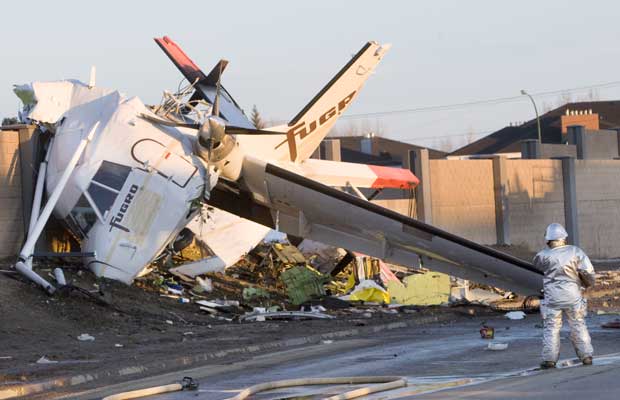
Lone Passenger Iaroslav Gorokhovski, a 47-year-old man from Embrum, Ont. Canada, died at the scene. In All Modes of Transport Dangers Are Inherit -- But Here Even The Data Collection Was Covered By Insurance Is Your Domestic & International Cargo Covered? Editor NoteThese pilots may very well have given their lives to avoid the homes and the grocery store during their emergency re-approach to John G. Diefenbaker International Airport. The number of actual heroes in our industry is beyond measure. INDEX For This Feature Fugro CorpWiki CONTRIBUTOR For This Feature Our Doc - an important contributor who must remain anonymous |
|
|

Catch This Deal Fast - Before It Floats Away From The Cargo Letter - March 11 2011 - The Cargo Was Steak & LobsterIt is normally the vallet who brings our car after a fine dining experience, but that process also required the intervention of a tug boat for diners at the Waterfront restaurant on March 11. 
Jeff Ruby's Waterfront Restaurant - Stuck Under The Bridge Which Carries U.S. Highway 127 Across The Ohio River
People Could Only Be Rescued One At A Time, So It Took Several Hours To Evacuate. No injuries Were Reported. Date of The Next Voyage Has Not Been Announced. Reader Comment - March 14 2011"Although the restaurant has a great view of Cincinnati 'Ohio', it's actually normally docked in Covington, 'Kentucky'."Lee Anne Ward, PMP CONTRIBUTOR For This Feature Sean Garcia |
RETURN TO "Singles Only" MAIN INDEX
NOTE: The Cargo Letter wants you to know that by keeping the identity of our contributors 100% confidential, you are able to view our continuing series of "Cargo Disasters.". Our friends send us materials which benefit the industry. The materials are provided to our news publication with complete and enforceable confidentiality for the sender. In turn, we provide these materials to you.NOTE: Please bring to our immediate attention any feature information which you believe may be incorrect.
| Cargo law Main Page | The Freight Detective | Law Navigator | Claims Calculator |
| The Freight Detective General Investigations | The Freight Detective Transport Investigations |
| The Logistics Chain | Photo Gallery of Cargo Loss | Our Staff |
| Trans-Cams | Forwarder/Broker Industry Chat & Issue Discussion Board |

The Law Offices of Countryman & McDaniel
Eleventh Floor LAX Airport Center
5933 West Century Boulevard
Los Angeles, California, 90045
(310) 342-6500 Voice
(310) 342-6505 Fax
![]() to
The Law Offices of Countryman &
McDaniel
to
The Law Offices of Countryman &
McDaniel